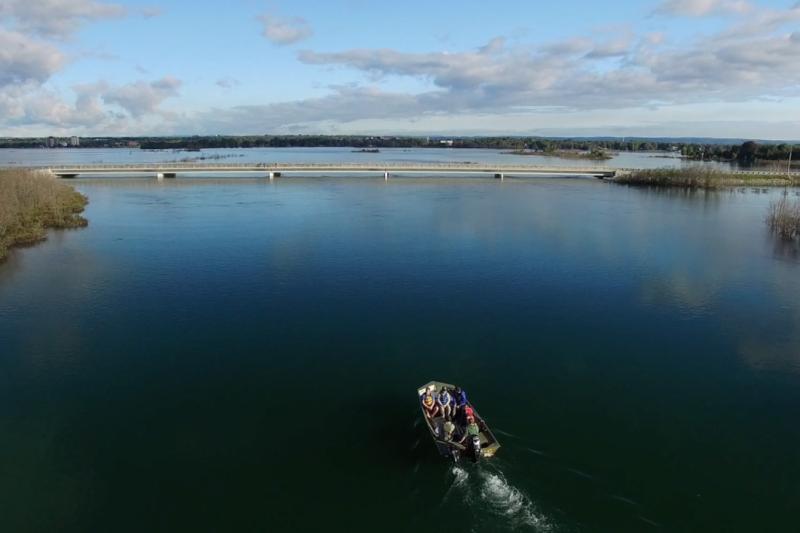NOAA Fisheries is recommending $4.78 million for eight Great Lakes Restoration Initiative projects to restore habitat and improve resilience in degraded Great Lakes ecosystems.
This funding will provide multiple benefits to the environment and communities by supporting valuable fisheries and important coastal resources, improving the quality of our water by restoring coastal wetland function, providing recreational opportunities for the public's use and enjoyment, and increasing the resilience of our coastal and Great Lake communities to erosion and flooding.
Specifically, recommended projects will restore habitats for Great Lakes species by opening river systems to fish passage, reconnecting rivers to their floodplains, and restoring and enhancing river, stream and wetland habitats. While other projects will continue restoration of Great Lakes Areas of Concern—places where pollution has impacted ecosystems and the public’s ability to use natural resources.
Partners in these restoration efforts are from nonprofits, local governments, and state agencies all working to either bring years of planning to execution, or carefully designing new projects that will result in community and economic benefits.
We’re recommending funding for four new restoration projects and continued funding for two existing regional partnerships. These efforts include:

A restored habitat shoal provides a variety of habitats for fish and wildlife on the St. Clair-Detroit River System.
New Projects:
A new project removing high-priority fish passage barriers in the northern region of Michigan’s Lower Peninsula with Huron Pines Resource Conservation and Development Council. In the first year, project partners will replace two barriers with better performing structures to reconnect 23 miles of coldwater habitat for brook trout and other native species. ($500,000)
A new effort with long-time partners at the Great Lakes Commission undertaking diverse coastal restoration projects along the St. Clair-Detroit River System in southeast Michigan. The initial two projects will restore degraded coastal wetlands and nearshore habitats for fish to migrate, spawn and grow. ($1,624,589)
Working with Ducks Unlimited on a new project in Ohio that will reconnect more than 200 acres of coastal wetland habitat at the confluence of the Portage and Little Portage rivers, which lead to Lake Erie. The current infrastructure there is causing habitat conditions to decline significantly, impacting fish, wildlife, and outdoor recreational opportunities, and will be replaced. ($149,924)
Completing engineering and design of a habitat restoration project on Kids Creek with the Grand Traverse Bay Watershed Initiative in the northwestern area of Michigan’s Lower Peninsula. When complete, this project will replace culverts acting as barriers to water flow and fish migration, and improve habitat in and along the creek for fish and invertebrates. ($167,313)

A woman and child head out to fish at a pier on Muskegon Lake, a NOAA Habitat Focus Area.
Continued Efforts:
The second year of funding for coastal wetland and fish passage restoration project with Ducks Unlimited will take place in two areas of Ohio. The Toussaint Wildlife Area will see the third and final phase of a project to replace water infrastructure which negatively impacts how wetlands function. Additionally, Ducks Unlimited will develop engineering and design plans for a second phase of restoration at Howard Marsh Metropark, including the design of an additional 210 acres of coastal wetlands and 25 acres of upland forest. ($939,780)
Two additional ongoing efforts with the Great Lakes Commission include work on the Cuyahoga River in Ohio, and Muskegon Lake in Michigan, both Areas of Concern. The first is helping complete design and engineering for the restoration of two-thirds of a mile of the Cuyahoga River, and its floodplain at the Cascade Valley Metropark. Secondly, there are five projects aimed at restoring Muskegon Lake, including engineering and design at three properties to restore almost 18 acres of habitat and improve shoreline resiliency, develop long-term maintenance plans, and implement ecological monitoring for projects on Muskegon Lake. ($1,400,000)
The Great Lakes are one of the most important natural resources in the world. They are the largest freshwater system on earth, and are important economic resources, supporting industry, transportation, commercial and recreational fishing, and tourism.
NOAA’s work in the Great Lakes reduces the threats from habitat degradation, oil spills and other pollution, overfishing, and invasive species to support healthy ecosystems and economies relying on these valuable international resources. Since 2010, we have restored more than 3.500 acres of habitat for fish and wildlife and opened up more than 700 miles of rivers and streams for fish to migrate, a critical part of their life cycle.


